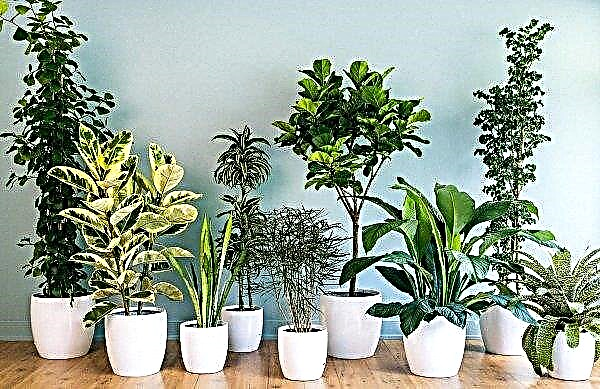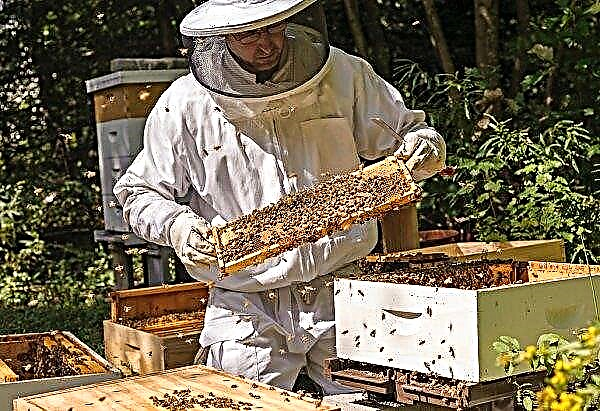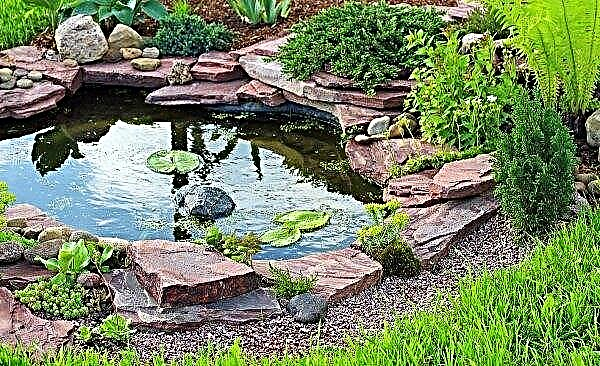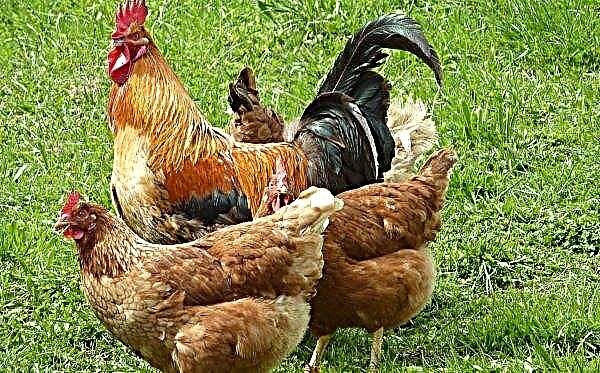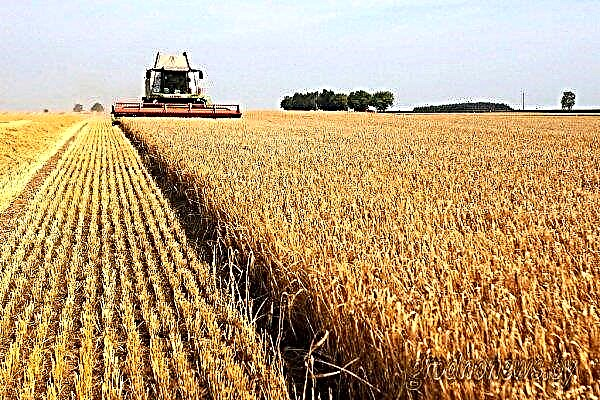In the modern market there are a huge number of options for greenhouses, so each summer resident can choose the most suitable variety for the site. Polycarbonate products have long been recognized as one of the most high-quality and reliable, especially since there are a considerable number of such structures. In this article, I would like to pay attention to the sliding design "Tulip", which in comparison with others has a lot of advantages.
Features of the Tulip greenhouse with opening roof and sides
Outwardly, the greenhouse resembles conventional arched polycarbonate products, additionally equipped with guides for opening and closing the side doors and roof. The design features of such a greenhouse give it many advantages, although, like in any other product, possible disadvantages cannot be ruled out. Consider each group of characteristics.
Did you know? The history of polycarbonate has more than one decade, because the first monolithic material was invented back in 1955 for use in the defense and space industries, as well as for the manufacture of parts in military engineering. Cellular polycarbonate sheets appeared much later - in 1976.
Benefits
The indisputable advantages of the polycarbonate "Tulip" include the following features:
- High strength framemade primarily from solid, one-piece arches. They are connected to each other by transverse slats and make it possible to withstand almost any weather conditions. Neither snowfall nor rain can damage a strong frame base, not to mention gusts of wind, even strong ones.
- Galvanized surface metal parts of the support allows you to not worry about corrosion processes for the entire period of operation of the shelter.
- Compact and pretty aesthetic design greenhouses can easily fit into the general view of any site, especially since you can always choose the most suitable size for the structure.
- Sliding mechanism mini-greenhouses simplifies the care of crops due to the possibility of two-way access to them.
- Universality of application - Another strength of the greenhouse. It is equally well suited for gardening or horticultural activities, as well as to complement an outdoor cafe, use as a terrace or gazebo.
- At low power consumption polycarbonate material is able to provide a sufficiently high temperature throughout the year, which saves on heating.
- The mobile qualities of such a greenhouse will also be useful., because over time it can easily be disassembled and moved to another place.
- Full set. When ordering a finished product, you don’t have to look for the individual necessary parts, all that is needed is included in the kit (even polycarbonate comes in a cut form).
- Thanks to modular design if necessary, you can always increase the length of the "Tulip" by 4-10 m, and each additional two-meter part is supplied in separate packages.

Disadvantages
- Despite all its positive qualities, the Tulip greenhouse is not without certain drawbacks:
- polycarbonate coating eventually loses its attractive appearance and looks worse than a glass structure of the same age;
- if some part of the material is damaged, replacing this area will cost a decent amount;
- the high cost of the complete set of the product (despite the fact that polycarbonate sheets are not always included in the purchased set and they often have to be purchased separately, the starting price for such greenhouses is not lower than 25,000 rubles).
Other significant disadvantages of the purchase of “Tulip” were not found, except that some gardeners are not always comfortable opening the doors up, but you can quickly get used to this feature.
Tulip Design Features
To understand in more detail all the features of the described product (both positive and negative), it is worth exploring its main characteristics: possible sizes, manufacturing materials, typical equipment of the manufacturer.
Dimensions
In this regard, the described greenhouse is universal and can be installed both on a large and a very small area, since the size range includes both four-meter and ten-meter structures. True, the width and height of the products are always the same - 3 m and 2.1 m. Given the presence of a sliding mechanism, you do not have to worry about the extra space for opening the door, which means that you can put the greenhouse right next to open beds.

Materials
The greenhouse frame is usually made of galvanized pipes of size 40 × 20 mm, the individual parts of which are connected by welding. In similar welded structures for other types of greenhouses, the thickness of the pipes is less (20 × 20), which allows us to talk about the increased strength of the Tulip. In addition, the “smart” four-bolt fastener, which, according to the manufacturer, should be stronger than welding, contributes to the stability of the greenhouse. The base of the greenhouse is covered with polycarbonate sheets with a thickness of 4-6 mm each and a density of at least 0.65 kg / cu. m
The sliding roof is also made of polycarbonate, so it is very easy to move it for ventilation or lift it up completely for the winter (the absence of snow load contributes to a longer operation of the greenhouse).Important! All mechanisms of the greenhouse with opening sides and a roof are made of all-welded pipe, which significantly increases the rigidity of the finished product in comparison with similar collapsible greenhouses.
Equipment
The majority of polycarbonate greenhouses "Tulip" are supplied with everything that is needed to collect them (supports and fasteners), except for the polycarbonate sheets themselves. If you come across just such a set, make sure that the end profile matches the thickness of the covering material. At each end of the greenhouse there are two doors with a window leaf.

For their fastening, the set includes special guides that reliably hold the sashes and the roof in the position specified by the owner. Another positive feature of this profile is its high resistance to ultraviolet radiation, which means that it is not afraid of destructive solar exposure.
Build Features
To assemble the Tulip greenhouse, you will need to prepare the usual set of tools: a screwdriver with nozzles (a cross and an 8 mm hexagon), a 10 mm wrench, a construction knife with a retractable blade, a level and a tape measure.
In addition, it is useful to additionally organize a reliable foundation for the greenhouse, which can be monolithic, strip or timber. Despite the fact that its presence is not a prerequisite for the construction of the greenhouse, it will significantly increase its stability, which is especially important for regions with unforeseen weather conditions.
Important! All work is preferably carried out in cotton gloves with a polymer coating applied to the surface. This will prevent slipping hands when working with polycarbonate sheets.
In an extreme case, to strengthen the structure, it is worth using the lugs included in the kit. With their help, you can fix the greenhouse directly in the ground, however, for this the base should be perfectly flat, which will help to avoid skewing of the finished structure.
Detailed assembly instructions for the Tulip greenhouse can always be obtained along with a set of main parts from the manufacturer. Given the all-welded type of frame arches, the presence of all necessary elements (including interconnected ones), there should be no problems with the construction of the greenhouse.
Video: Assembling the Tulip Greenhouse
Buying Criteria
Choosing a greenhouse "Tulip", first of all, you need to find a good manufacturer, then the main evaluation criteria will find a positive review.
When evaluating the proposed product, pay attention to:
- dimensions corresponding to the free space available on the territory;
- material of manufacture of supports (it must be galvanized pipes of size 40 × 20, not thinner);
- the presence of a sufficient number of jumpers between the main rails (in the finished form, the assembled frame should look coarse, composed of a large number of squares);
- material for the manufacture of slide-out guides: it is desirable that they be created from all-welded metal pipes;
- availability of polycarbonate sheets in the kit. If they are, make sure that all material has the necessary insulation coating and a thickness of at least 4 mm.
Did you know? The largest greenhouse in history can be called the Crystal Palace existing in the 19th century. This glass building was built in the UK for the fair, and simultaneously housed more than 1300 exhibitions and more than six million visitors. Unfortunately, to this day this building "did not survive": it was dismantled at the beginning of the twentieth century.
No less important selection criteria are the characteristics of the fasteners. Like the main parts, they must be made of high-quality metal and have wide caps that protect against rain from flowing through the mounting holes.
What can be grown in such a greenhouse
One of the main advantages of polycarbonate greenhouses "Tulip" is their versatility. This means that they are suitable for growing any plants - both garden and garden ones. In addition, such a shelter is convenient to use for flowers, in particular tulips, in honor of which the design got its name.

Simply put, the described construction will be useful for both ordinary summer residents and botanists involved in selective work or industrial plant cultivation, and given the ease of assembly and the most complete set of many sets, organizing such a shelter on the site will not be difficult.

